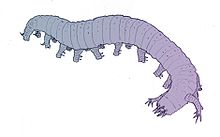Lobopod
| Lobopodia Fossil range: Cambrian Series 2–Early Pennsylvanian The taxa Onychophora and Tardigrada survive to Recent |
||||
|---|---|---|---|---|
 Reconstruction of the lobopod Aysheaia
|
||||
| Scientific classification | ||||
|
||||
| Included groups | ||||
|
||||
| Excluded groups | ||||
|
Crown-group Euarthropoda |
Crown-group Euarthropoda
The lobopodians, members of the informal group Lobopodia Snodgrass 1938 (from the Greek, meaning "blunt feet") are worm-like taxa with stubby legs.
The scope of the Lobopodian concept varies from author to author. Its most limited sense refers to a suite of mainly Cambrian panarthropod taxa with flexible non-segmented limbs – for example Aysheaia, Hallucigenia and Xenusion. A broader definition of lobopodia would also incorporate the extant phyla Onychophora and Tardigrada. The broadest definition proposes the (monophyletic) Superphylum Lobopodia to encompass all three panarthropod phyla.
The oldest near-complete fossil lobopodians date to the Lower Cambrian; some are also known from Ordovician, Silurian and Carboniferous Lagerstätten. Some bear toughened claws, plates or spines, which are commonly preserved as carbonaceous or mineralized microfossils in Cambrian strata.
The better-known genera include, for example, Aysheaia, which was discovered in the Canadian Burgess Shale and looks something like the modern velvet worms., and Hallucigenia, known from Chengjiang and the Burgess Shale. The latter taxon was originally reconstructed with long, stilt-like legs and mysterious fleshy dorsal protuberances, and was long considered a prime example of the way in which nature experimented with the most diverse and bizarre body designs during the Cambrian. However, further discoveries showed that this reconstruction had placed the animal upside-down: interpreting the "stilts" as dorsal spines made it clear that the fleshy "dorsal" protuberances were actually legs. This second reconstruction also exchanged the front and rear ends of the creature, which further investigation showed to be erroneous. A study published in 2014 concluded that Hallucigenia is an ancestor of modern onychophora based on its claws.
...
Wikipedia
